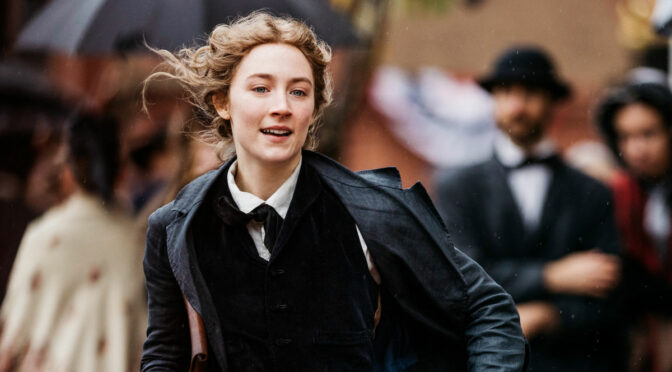Greta Gerwig’s adaptation of Louisa May Alcott’s novel is a moving and fresh tale with an expertly handled tone. Coming to the film without preconceptions based on Gillian Armstrong’s 1994 adaptation of the source material, viewers will find a period piece with a spring in its step. There are profound illustrations of the small moments that define life’s direction and the critical choices women face when determining their particular version of womanhood.
The March sisters – Amy (Florence Pugh), Beth (Eliza Scanlen), Meg (Emma Watson) and Jo (Saoirse Ronan) – are growing up in Concord, Massachusetts, during the era of the American Civil War. Jo is a pragmatic writer who rejects conventional female roles; Meg has more domestic ambitions despite her acting talent; Amy dreams of the more beautiful things in life; Beth is the musically gifted sister who lifts the spirits of her family despite her illness. We begin the story with Jo, before hopping back and forth across a ‘current’ timeline and one seven years prior, with both periods also involving the girls’ relationship with the rich boy next door, Theodore ‘Laurie’ Laurence (Timothee Chalamet).
In switching between timelines from the start, Gerwig’s script starts quite choppily. The introduction of the story feels rushed, and the use of the same actors to portray both ages with few costume and hair/makeup cues between them doesn’t allow for the smoothest take-off. However, the film quickly finds its rhythm, with the colour grading and cinematography acting beautifully to let the story flow back and forth in a natural way. Many films interweave backstory to contextualise ongoing events, but few achieve this as neatly as LITTLE WOMEN does for the majority of its runtime. The warm hues of the girls’ more straightforward, and perhaps happier, early days contrast with the cooler tones of the March home as Beth’s health tests the morale of her family.
The film balances our sympathies for the siblings. Although, at any one moment, the pendulum swings between who we feel the most empathy with, the script and dialogue present no one woman’s path as the more ‘worthy’. Central to this are the performances of the lead women. The heaviest lifting is done by Ronan, proving as capable as she did under Gerwig in LADY BIRD in communicating determination and vulnerability in equal measure. Watson’s Meg is a tricky proposition, for differing reasons depending on the point in the narrative: a single misstep and she can come across as an unambitious ingénue or an ungrateful nag lacking in understanding. The most defined arc, however, is delivered by Pugh. Not only does she manage to convey immaturity, handling a confusingly scripted portrayal of 13-year-old Amy (Pugh herself is in her early twenties) well, but also the character’s growth into an artist with a more mature emotional intelligence.
In terms of themes, the definition of womanhood plays a significant role, but there are also broader ideas at play. LITTLE WOMEN wonderfully communicates the ways in which small deviations in life can set you on a long path different from that you had imagined. Each of the sisters has unanticipated moments that then come to play considerable roles in where they find themselves as they become adults. In the case of the March sisters, the story frames this using the positions they adopt for themselves as women in nineteenth-century America, but the concept feels as relevant worldwide in the twenty-first century. The film only achieves this impact with the skilful management of the intertwining stories by Gerwig.
After a slightly rough start, LITTLE WOMEN blends the technical and narrative elements of the film to move and amuse. Much like the life of the March sisters, it is a multi-faceted story that feels ripped from the pages of a real and complicated set of experiences.


One thought on “Little Women”
Comments are closed.